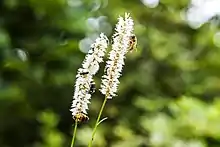| Bistorta manshuriensis | |
|---|---|
 | |
| Scientific classification | |
| Kingdom: | Plantae |
| Clade: | Tracheophytes |
| Clade: | Angiosperms |
| Clade: | Eudicots |
| Order: | Caryophyllales |
| Family: | Polygonaceae |
| Genus: | Bistorta |
| Species: | B. manshuriensis |
| Binomial name | |
| Bistorta manshuriensis | |
Bistorta manshuriensis (Hangul: 범꼬리), Asian bistort, is an unresolved name for a proposed flowering plant species in the buckwheat family Polygonaceae.[1] It is a perennial herbaceous plant found in mountain valleys and lowlands in Korea and Japan. It grows well in sunny or slightly shaded places.[2] It grows up to 30 centimetres (12 in) - 80 centimetres (31 in).
Medicinal uses
The plant contains tannins and flavonoids.[2] Their roots are used in Korean traditional medicine for treating diarrhoea and bleeding.[2][3]
References
- 1 2 "The Plant List: Bistorta manshuriensis Kom". Royal Botanic Gardens, Kew and Missouri Botanic Garden. 2013.
- 1 2 3 Medicinal plants in the republic of Korea. Natural Products Research Institute Seoul National University. 1998. p. 53. ISBN 92 9061 120 0.
- ↑ Natural Products Laboratory, School of Pharmacy. Phytochemical Constituents of Bistorta manshuriensis. Sungkyunkwan University. p. 15(4) : 234–240 (2009).
This article is issued from Wikipedia. The text is licensed under Creative Commons - Attribution - Sharealike. Additional terms may apply for the media files.